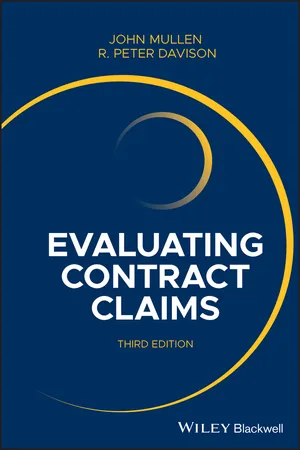
- English
- ePUB (mobile friendly)
- Available on iOS & Android
Evaluating Contract Claims
About this book
An important guide to the quantification of contract claims in the construction industry, updated third edition
The substantially expanded third edition of Evaluating Contract Claims puts the spotlight on the quantification of claims in the construction industry after liability has been established, including by reference to the terms of several standard forms of contract in common use. The authors clearly demonstrate the potential alternative approaches to quantification, the processes, principles and standard of analysis required to produce acceptable claims for additional payment. The third edition covers a number of heads claims not considered in previous editions and offers an important guide for those working with building or engineering contracts.
Evaluating Contract Claims explains in detail how the base from which evaluation of additional payments may be established, the effect of changes on the programme of work and the sources of information for evaluation of additional payments. The book also contains information for evaluating the direct consequences of change in terms of the impact on unit rates, and evaluating of the time consequences of change in terms of prolongation, disruption, acceleration and more. This important book:
- Concentrates on the quantification of contract claims after liability has been established
- Offers a guide that is appropriate for any form of contract
- Considers the potential alternative approaches to quantification of different heads of claim
- Contains the principles and methods that should be reflected in the evaluation of claim quantum
- Includes the standard of substantiation which may be required
- Presents information that is equally applicable in both building and engineering disputes
- Is substantially expanded from its previous editions
Written for construction and engineering contract administrators, project managers, quantity surveyors and contract consultants, Evaluating Contract Claims offers a revised third edition to the essential guide for quantifying claims in the construction industry once liability has been established.
Frequently asked questions
- Essential is ideal for learners and professionals who enjoy exploring a wide range of subjects. Access the Essential Library with 800,000+ trusted titles and best-sellers across business, personal growth, and the humanities. Includes unlimited reading time and Standard Read Aloud voice.
- Complete: Perfect for advanced learners and researchers needing full, unrestricted access. Unlock 1.4M+ books across hundreds of subjects, including academic and specialized titles. The Complete Plan also includes advanced features like Premium Read Aloud and Research Assistant.
Please note we cannot support devices running on iOS 13 and Android 7 or earlier. Learn more about using the app.
Information
1
Introduction
1.1 The Legal Basis
1.1.1 Forms of Contract
| ‘Infrastructure Conditions’ | Infrastructure Conditions of Contract published in August 2011, Measurement Version, published by the Association for Consultancy and Engineering (ACE) and Civil Engineering Contractors Association (CECA). |
| ‘FIDIC Red Book’ | The Fédération International des Ingénieurs‐Conseil's (FIDIC) Conditions of Contract for Construction, for Building and Engineering Works designed by the Employer, First Edition 1999. |
| ‘SBC/Q' | The Joint Contract Tribunal's Standard Building Contract with Quantities (SBC/Q), published in 2011 by Sweett and Maxwell. The successor to the previously published ‘JCT’ Standard Form of Contract. |
| ‘NEC4‐ECC’ | The Engineering and Construction Contract, Fourth Edition 2017, published by Thomas Telford Ltd. In this book references to ‘NEC4‐ECC’ are generally to its Option A: Priced contract with activity schedule. |
1.2 The Standard of Substantiation
- The first principle is that he or she who asserts must prove, i.e. the party claiming an item of damage, cost expense, loss or value, will have to support it with evidence.
- The second principle is the general standard of proof in many jurisdictions, as it is put in English law, that matters need to be established as being correct ‘on the balance of probability’. This contrasts with the standard required in criminal matters where ‘beyond reasonable doubt’ is the test under English law. This second principle might, however, be subject in practice to a ‘sliding scale’, i.e. major and central parts of the issues need to be fully substantiated while ancillary or subsidiary parts may be subject to a lesser degree of substantiation. Those minor parts may perhaps be assessed by reference to the results of the more rigorous analysis of the major parts, perhaps on a pro rata basis. If a sufficient and representative sample of preliminaries and general item costs in a prolongation claim have been agreed following detailed checking at x% of their claimed values, then it might be concluded that the unsampled costs could also be agreed at that x%.
Table of contents
- Cover
- Table of Contents
- Reviews
- Preface
- Acknowledgements
- 1 Introduction
- 2 Establishing the Base
- 3 Effect of Change on Programmes of Work
- 4 Sources of Financial Information for Evaluation
- 5 Evaluation of the Direct Consequences of Change
- 6 Evaluation of the Time Consequences of Change
- 7 Termination Claims
- 8 Other Sources of Claims
- 9 Minimising the Consequences of Change
- Appendix A: Example of Financial Accounts
- Appendix B: Example of Management Accounts
- Table of Cases
- Index
- End User License Agreement